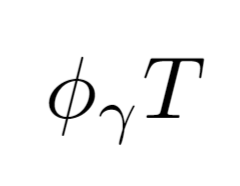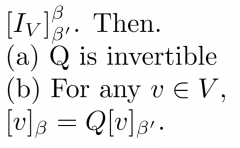![]()
![]()
![]()
Use LEFT and RIGHT arrow keys to navigate between flashcards;
Use UP and DOWN arrow keys to flip the card;
H to show hint;
A reads text to speech;
50 Cards in this Set
- Front
- Back
|
direct sum |

|
|
|
vector space |
addition: commutative, associative, identity, inverse scalar multiplication: identity, (ab)x = a(bx) distributive: (a + b)x = ax + bx; a(x + y) = ax + ay |
|
|
subspace |
contains 0 vector, closed under addition and scalar multiplication |
|
|
Theorem 1.4: Any intersection of subspaces.. |
or a vector space V is a subspace of V. |
|
|
coset of W containing v |
{v} + W = {v + w: w in W} |
|
|
Theorem 1.5: The span of any subset S of a vector space V |
is a subspace of V. Moreover, any subspace of V that contains S must also contain the span of S. |
|

|
If S1 is linearly dependent, then S2 is linearly dependent.
If S2 is linearly independent, then S1 is linearly independent. |
|
|
Theorem 1.7: Let S be a linearly independent subset of a vector space V, and let v be in V but not in S... |
Then S U {v} is linearly dependent iff v is in span(S). |
|
|
Theorem 1.8: Let V be a vector space and beta = {u1, u2,..., un} be a subset of V. Then beta is a basis iff |
each v in V can be uniquely expressed as a linear combo of vectors of beta. |
|
|
Theorem 1.9: If a vector space is generated by a finite set S, then... |
some subset of S is a basis for V. Hence V has a finite basis. |
|
|
Theorem 1.10 (Replacement Theorem): Let V be a vector space generated by a set G containing n vectors, and let L be a lin. ind. subset of V containing m vectors... |
Then m <= n, and there exists a subset H of G containing n - m vectors such that L U H generates V. |
|
|
Theorem 1.10 Corollary 1: Let V be a vector space having a finite basis. Then... |
every basis for V contains the same number of vectors. |
|
|
Theorem 1.10 Corollary 2: Let V be a vector space with dimension n.. |
a) Any finite generating set for V contains at least n vectors, and a generating set for V that contains exactly n vectors is a basis for V. b) Any linearly ind. subset of V that contains exactly n vectors is a basis for V. c) Every linearly ind. subset of V can be extended to a basis for V. |
|
|
Theorem 1.11: Let W be a subspace of a finite-dimensional vector space V. |
Then W is finite-dimensional, and dimW <= dimV. Moreover, if dim(W) = dim(V), then V = W. |
|
|
Theorem 1.11 Corollary: If W is a subspace of a finite-dimensional vector space V, then any basis for W... |
can be extended to a basis for V. |
|
|
maximal |
Let F be a family of sets. A member of F is called maximal if M is contained in no member of F other than M itself |
|
|
Maximal Principle. |
Let F be a family of sets. If, for each chain C in F, there exists a member of F that contains each member of C, then F contains a maximal member. |
|
|
Theorem 1.12: Let V be a vector space and S a subset that generates V. |
If beta is a maximal lin. ind. subset of S, then beta is a basis for V. |
|
|
Theorem 1.13: Let S be lin. ind. subset of a vector space V. Then there exists... |
a maximal lin. ind. subset of V that contains S. |
|
|
Linear transformation |
T(x + y) = T(x) + T(y) T(cx) = cT(x) |
|
|
Theorem 2.1: Let V and W be vector spaces and T: V -> W be linear... |
N(T) and R(T) are subspaces of V and W, respectively. |
|
|
Theorem 2.2: Let V and W be vector spaces and T: V -> W be linear. If beta = {v1, v2, ..., vn} is a basis for V, then... |
R(T) = span(T(beta)) = span({T(v1), T(v2), ..., T(vn)}) |
|
|
Theorem 2.3 (Dimension Theorem) |
if V is finite dimensional, then nullity(T) + rank(T) = dim(V). |
|
|
Theorem 2.4: T is one-to-one |
iff N(T) = {0} |
|
|
Theorem 2.5: dim(V) = dim(W) (finite) |
T is one-one <=> T is onto <=> rank(T) = dim(V) |
|
|
Theorem 2.6: {v1, v2, ..., vn} is a basis for V. For w1, w2, ..., wn in W... |
there exists exactly one linear transformation T: V -> W such that T(vi) = wi for i = 1, 2, ..., n. |
|
|
Theorem 2.6 Corollary: V has finite basis {v1, v2, ..., vn}. If U, T: V -> W are linear and U(vi) = T(vi) for i = 1, 2, ..., n... |
U = T |
|
|
T-invariant |
T: V -> V is linear. Subspace W of V is T-invariant if T(x) \in W for every x in W. |
|
|
L(V, W) |
vector space of all linear transformations from V into W.. |
|
|
Theorem 2.8: Let V and W be finite-dimensional vector spaces with ordered bases beta and gamma, and let T, U: V -> W be linear. Then... |

|
|
|
Theorem 2.9: Let V, W, and Z be vector spaces o ver the same field F, and let T: V -> W and U: W -> Z be linear. |
Then UT: V -> Z is linear. |
|
|
Theorem 2.10. Let V be a vector space. Let T, U1, U2 be in L(V). Then. |

|
|
|
The V, W, and Z be finite-dimensional vector spaces with ordered bases alpha, beta, and gamma. Let T: V --> W and U: W -> Z be linear transformations. Then... |

|
|
|
Corollary to Theorem 2.11: Let V be a finite-dimensional vector space with an ordered bais beta. Let T, U be in L(V). Then... |

|
|
|
Theorem 2.14: Let V and W be finite-dimensional vector spaces having ordered bases beta and gamma, and let T: V -> W be linear. Then for each u in V we have... |

|
|
|
Theorem 2.15: Let A be m x n (F). Then the left-multiplication transformation is linear. B is any other m x n matrix, beta and gamma standard ordered bases for Fn and Fm... |

|
|
|
facts for invertible functions T and U |

|
|
|
Theorem 2.17: Let V and W be vector spaces, and let T: V -> W be linear and invertible... |
Then inverse of T: W -> V is linear. |
|
|
Lemma on page 101. Let T be an invertible linear transformation from V to W. |
Then V is finite-dimensional iff W is finite-dimensional. Then dim(V) = dim(W). |
|
|
Theorem 2.18: Let V and W be finite-dimensional vector spaces with ordered bases beta and gamma. Let T: V -> W be linear. Then T is invertible iff |

|
|
|
Corollary 2, Thm 2.18: Let A be an n x n matrix. Then A is invertible iff |

|
|
|
Theorem 2.19. Let V and W be finite-dimensional vector spaces. Then V is isomorphic to W iff |
dim(V) = dim(W) |
|
|
Theorem 2.20: Let V and W be finite-dimensional vector spaces over F of dimensions n and m, and let beta and gamma be ordered bases. The function phi |

|
|
|
Corollary to 2.20: Let V and W be finite-dimensional vector spaces of dimensions n and m. The L(V, W) |
is finite-dimensional of dimension mn. |
|
|
standard representation of V with respect to beta |

|
|

|

|
|
|
Theorem 2.22: Let beta and beta' be two ordered bases for a finite-dimensional vector space V, and let Q = |

|
|
|
linear operator |
linear transformation that map a vector space into itself |
|
|
Theorem 2.23: Let T be a linear operator on a finite-dimensional vector space V, and let beta and beta' be ordered bases for V. Suppose Q is the change of coordinate matrix that changes beta'-coordinates into beta-coordinates. Then... |

|
|
|
B is similar to A if |
there exists an invertible matrix Q such that B = Q^-1AQ |

